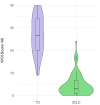Daily living skills in adolescents with and without (developmental) language disorder, measured using the WHEEL OF INDEPENDENCETM framework
- PMID: 40343221
- PMCID: PMC12033610
- DOI: 10.1177/03080226241280732
Daily living skills in adolescents with and without (developmental) language disorder, measured using the WHEEL OF INDEPENDENCETM framework
Abstract
Introduction: Developing daily living skills, such as self-care, cooking and managing money, is a key priority for adolescents with special educational needs. Previous studies investigated the emergence of daily living skills in young people with a range of neurodevelopmental conditions. However, none focused on adolescents with language disorders, including developmental language disorder.
Method: Two groups of 16-year-olds participated in this study: a typically developing group (n = 88) and a (developmental) language disorder group (n = 78), which was subdivided into participants with co-occurring motor difficulties (n = 56) versus typical motor development (n = 22). Data were collected using the WHEEL OF INDEPENDENCE™ framework, a daily living skills measurement tool. Between-group comparisons assessed whether there were significant differences in daily living skills between typically developing and (developmental) language disorder participants and between those with and without motor difficulties within the (developmental) language disorder group.
Results: Findings revealed that typically developing participants had significantly better daily living skills than the (developmental) language disorder group. Within the (developmental) language disorder group, participants with motor difficulties showed marginally significantly lower daily living skills than those without.
Conclusion: Adolescents with (developmental) language disorder experience challenges developing their daily living skills, compared to typically developing peers. This may be compounded if they have co-occurring motor difficulties. Further research could inform understanding of the mechanisms underlying these differences in order to develop tailored and effective interventions.
Keywords: Developmental language disorder; adolescents; daily living skills; motor skills; occupational therapy.
© The Author(s) 2024.
Conflict of interest statement
The author(s) declared the following potential conflicts of interest with respect to the research, authorship, and/or publication of this article: DB, LH, ND and SE are employed by Moor House School & College which sells resources and courses on the WHEEL OF INDEPENDENCE™ framework. There are no other conflicts of interest.
Figures







References
-
- Bruininks RH, Bruininks BD. (2005) Bruininks-Oseretsky Test of Motor Proficiency, 2nd edn. Oxford: Pearson Clinical Assessment.
-
- Burridge D, Ni Fhlatharta M. (2022) Developing Self-care Skills. Oxted: Moor House School & College.
-
- Carter EW, Austin D, Trainor AA. (2012) Predictors of postschool employment outcomes for young adults with severe disabilities. Journal of Disability Policy Studies 23(1): 50–63.
LinkOut - more resources
Full Text Sources
Research Materials
